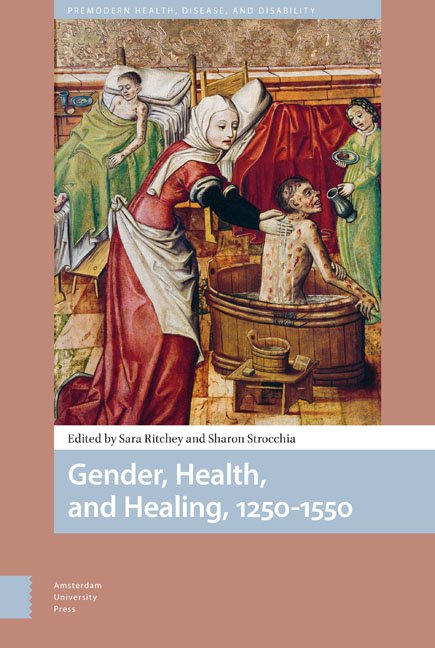Book contents
- Frontmatter
- Contents
- List of Figures and Tables
- Acknowledgments
- Abbreviations
- Introduction: Gendering Medieval Health and Healing: New Sources, New Perspectives
- Part 1 Sources of Religious Healing
- 1 Caring by the Hours: The Psalter as a Gendered Healthcare Technology
- 2 Female Saints as Agents of Female Healing: Gendered Practices and Patronage in the Cult of St. Cunigunde
- Part 2 Producing and Transmitting Medical Knowledge
- 3 Blood, Milk, and Breastbleeding: The Humoral Economy of Women's Bodies in Medieval Medicine
- 4 Care of the Breast in the Late Middle Ages: The Tractatus de passionibus mamillarum
- 5 Household Medicine for a Renaissance Court: Caterina Sforza's Ricettario Reconsidered
- 6 Understanding/Controlling the Female Body in Ten Recipes: Print and the Dissemination of Medical Knowledge about Women in the Early Sixteenth Century
- Part 3 Infirmity and Care
- 7 Ubi non est mulier, ingemiscit egens?: Gendered Perceptions of Care from the Thirteenth to Sixteenth Centuries
- 8 Domestic Care in the Sixteenth Century: Expectations, Experiences, and Practices from a Gendered Perspective
- 9 Bathtubs as a Healing Approach in Fifteenth-Century Ottoman Medicine
- Part 4 (In)fertility and Reproduction
- 10 Gender, Old Age, and the Infertile Body in Medieval Medicine
- 11 Gender Segregation and the Possibility of Arabo-Galenic Gynecological Practice in the Medieval Islamic World
- Afterword: Healing Women and Women Healers
- Contributors
- Index
9 - Bathtubs as a Healing Approach in Fifteenth-Century Ottoman Medicine
Published online by Cambridge University Press: 23 June 2021
- Frontmatter
- Contents
- List of Figures and Tables
- Acknowledgments
- Abbreviations
- Introduction: Gendering Medieval Health and Healing: New Sources, New Perspectives
- Part 1 Sources of Religious Healing
- 1 Caring by the Hours: The Psalter as a Gendered Healthcare Technology
- 2 Female Saints as Agents of Female Healing: Gendered Practices and Patronage in the Cult of St. Cunigunde
- Part 2 Producing and Transmitting Medical Knowledge
- 3 Blood, Milk, and Breastbleeding: The Humoral Economy of Women's Bodies in Medieval Medicine
- 4 Care of the Breast in the Late Middle Ages: The Tractatus de passionibus mamillarum
- 5 Household Medicine for a Renaissance Court: Caterina Sforza's Ricettario Reconsidered
- 6 Understanding/Controlling the Female Body in Ten Recipes: Print and the Dissemination of Medical Knowledge about Women in the Early Sixteenth Century
- Part 3 Infirmity and Care
- 7 Ubi non est mulier, ingemiscit egens?: Gendered Perceptions of Care from the Thirteenth to Sixteenth Centuries
- 8 Domestic Care in the Sixteenth Century: Expectations, Experiences, and Practices from a Gendered Perspective
- 9 Bathtubs as a Healing Approach in Fifteenth-Century Ottoman Medicine
- Part 4 (In)fertility and Reproduction
- 10 Gender, Old Age, and the Infertile Body in Medieval Medicine
- 11 Gender Segregation and the Possibility of Arabo-Galenic Gynecological Practice in the Medieval Islamic World
- Afterword: Healing Women and Women Healers
- Contributors
- Index
Summary
Abstract
The fifteenth-century Ottoman physician Muhammad al-Shirwānī’s extensive encyclopedia of pharmaceutical science, Rawḍat al-ʿiṭr (Garden of pharmacy/perfumes’), is an important source for understanding Ottoman medicine. The work includes a specific chapter about using bathtubs in urgent cases, along with self-prepared remedies. This essay contextualizes al-Shirwānī's encyclopedia within the traditions of Arabic and Ottoman medicine. It presents the first English translation of al-Shirwānī's chapter on bathtubs and analyses the kinds of ailments that could be treated by this technique, as well as the types of materia medica used in therapeutic preparations. Al-Shirwānī's inclusion of an extended chapter devoted specifically to this home-based approach suggests that household medicine was emerging as an authoritative terrain of both Arabic and Ottoman medicine.
Keywords: household medicine, pharmacy, materia medica, balneology
One of the most widespread therapeutic approaches used around the world involves the bathtub as a healing device to treat certain ailments. Using this mode of treatment achieves a number of therapeutic benefits. Bathtubs permit external remedies to achieve a significant amount of contact with the skin surface. Users gain additional benefits from exposure to the warm water in treatment. Moreover, the treatment can be applied at home without the patient's need to leave, thereby eliminating the difficulties associated with out-of-home treatments. This advantage can be especially important in cases of severe pain; indeed, using a bathtub can be considered a form of household medicine.
In the contemporary world, the term ‘therapeutic tourism’ has emerged, based mainly on the principles of a bathtub approach to therapy. Many specialized clinics have emerged around the world to advance this type of treatment, especially for older people or those suffering from certain movement disabilities, articulated pains, or other conditions. One of the most famous tourist destinations in this regard is Turkey, where many centres can be found in Istanbul and other cities. This is not surprising considering that Ottoman medicine relied heavily on home-based processing using the bathtub. Indeed, visitors to Istanbul can visit a museum that specializes in the culture of Ottoman-era baths and the medical treatment methods used.
- Type
- Chapter
- Information
- Gender, Health, and Healing, 1250–1550 , pp. 245 - 264Publisher: Amsterdam University PressPrint publication year: 2020



